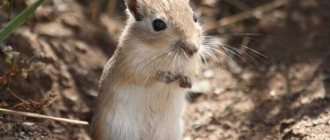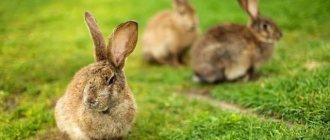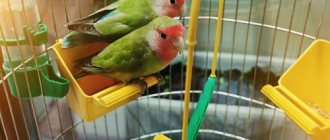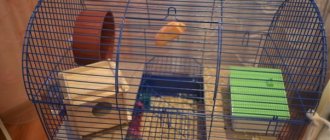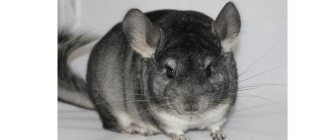Review author: “ZooVita”
A domestic decorative rabbit is a kind and sweet animal that can give a person joy and cheer him up. They are friendly and do not require special attention. They are easy to care for if you have at least the slightest idea about the chosen breed and the rules of maintenance.
Photos of decorative rabbits are touching. They look attractive and attractive: you definitely want to pick them up and caress them. Therefore, children have a special interest in them. The child is drawn to a homemade living “toy”, and the rabbit himself is not against such communication.
In order for your pet to be healthy and delight your family with its presence longer, you need to know some rules of care and maintenance.
Features of decorative rabbits
The purpose is in the name itself. They are not raised for fur or meat. People need them as a pet that requires care.
Most often, rabbits are taken for the sake of children, in order to instill in them a sense of responsibility, love and kindness. It’s impossible not to pay attention to a fluffy ball in a pet store!
The rabbit has many advantages:
- characterized by calm behavior;
- unlike cats, it is less active;
- unlike dogs, it is not capable of making loud sounds or making noise.
Features of choosing a dwarf rabbit
Dwarf animals were first bred in the 19th century by English breeders. They were presented at an exhibition called "Polish rabbit". German breeders supported their colleagues and introduced the Hermelin breed to the world.
These two breeds had standard colors, but Dutch breeders were able to create a real sensation and bred small fluffies of various colors. Over time and with the hard work of breeders, such breeds of rabbits as the Lop-Eared Ram, Angora, Dwarf Fox, Rex, Lion's Head and many others were developed. Today in a pet store or at a bird market you can find many small rodents that will differ from each other in color, size, length of fur and ears. It is best to buy rabbits at the age of 1.5 months and older, but most often they are sold after reaching 3-4 months. At this age, the weight of the animal should not exceed 1.8 kg.
However, age is not the most important thing when choosing. The pet's health must be good. That is why it is worth paying special attention to the ears, nose, eyes, coat and mobility of the rodent. A healthy rabbit should have clean ears, shiny eyes and under no circumstances be sour. The coat is thick and has a natural shine.
Did you know? Dwarf rabbits are an exact copy of their older brothers. They are similar to them not only in appearance, but also in their lifestyle, habits, and character.
It is also worth observing for some time the activity of the animal you like. After all, if he is huddled in a corner and practically does not move, then these are the first signs of illness. In addition, furry cats must have vaccinations against VGBV and myxomatosis. You can ask the seller for proof of vaccination.
One of the difficulties when choosing dwarf rabbits is determining the sex. By the age of three months, the males' testicles descend and can be clearly seen. In order to distinguish a female from a male, it is necessary to turn the animal on its back and with your hand push back the tail, which they instinctively press. The testicles in boys have the appearance of a tumor. In rabbits, the genitals have a slit-like opening and are located at a small distance from the anus.
When choosing purebred dwarf rabbits, you need to pay attention to the basic standards. Unfortunately, these characteristics are often abused by unscrupulous sellers and used for personal gain. That is why it is necessary to know what signs to use to determine whether an animal is purebred.
Find out how to correctly determine the sex of a rabbit.
General signs of purebredness
There are more than ten species of rabbit breeds in the world, which are generally considered dwarf. All of them, depending on the length of the coat, can be divided into 3 groups:
- short-haired - the size of the hair and fluff is no more than 2 cm;
- normal - hair of medium length varies from 2.5 to 4 cm, and may have fluff, the length of which ranges from 2 to 2.5 cm;
- long-haired - have thick hair, the length of the hair reaches 5 cm, and in some even more.
In addition to length, the coat varies in silkiness and softness.
The weight of dwarf rabbits varies from 1.5 to 1.8 kg. At the same time, the length of the body is 32–34 cm. It has a compact round shape, and the body of the animals is slightly flattened in length. Against the background of a small body, the head looks large, and this is not surprising, because it is ½ the size of the body. Dwarf rabbits have practically no necks. Animals' ears can be erect or drooping. Their length often does not exceed 6 cm. Read more about the dwarf ram rabbit.
Permissible deviations are normal
As with any rule, there are exceptions when determining the purebred of dwarf breeds. For example, one of the most popular breeds of dwarf rodents, the Dutch rabbit , has a body weight ranging from 2 to 3 kg. They are white and black in color, but there are individuals with a bluish, tortoiseshell or chocolate contrasting tint.
Although most animals of this species have small ears, for the Lop-eared sheep the ears are a real asset and can have a length of 23 to 27 cm.
Animals of the Lion's Head breed amaze with their unusual fur . They have a characteristic mane, which is a distinctive feature for this breed. However, they may have a recessive gene, that is, a gene that is suppressed by a dominant one, and as a result, this breed will not have a characteristic feature.
Difference between decorative and dwarf rabbit
Buyers often confuse these two concepts. Any pet, regardless of its size, kept in the house can be called decorative. This is a pet.
Dwarf species include fluffies, whose size is small. They can also take the place of a family pet.
Types of decorative rabbits
There are many decorative types, which for the sake of order and systematization are distinguished by:
- sizes;
- coloring;
- fur length.
Breeds of decorative rabbits
There are many types and breeds of decorative rabbits: 200 are known today. Moreover, selection continues! The most common and popular decorative fluffies include:
Fold-eared decorative rabbits
This species includes the Dutch breed and the dwarf ram. A distinctive feature is drooping ears, although the born “babies” have protruding ones.
Decorative rabbit of the Gremlin breed
Small sizes. Color – white. Eye color – gray. An animal with short legs, a round, slightly flattened face, and erect straight ears. Gremlin can be called a long-liver. With proper care it can live 10-12 years.
Decorative Rex rabbit
The breed is friendly with a gentle character. Has a dark brown color. An animal with a short tail and paws, with a round graceful face and protruding, short ears.
Decorative rabbit of the Pygmy breed
These are small rabbits that prefer warmth. They jump very little because their legs are too short. They live no more than 5 years.
It is impossible to list all breeds in one article. There are a lot of them: fox, lion, butterfly, squirrel, hare and others.
Breeds and general description
You will be surprised, but this is exactly what a dwarf ram looks like
When the decision to have a dwarf rabbit has been made, you need to decide on the choice of breed. Such animals are colored and white, and their weight ranges from 700 g to 3 kg.
The following breeds can be found in nurseries and pet stores:
- Dwarf ram;
- Dwarf rex;
- Foxy dwarf rabbit;
- Angora dwarf rabbit;
- Japanese dwarf rabbit;
- Dwarf hare;
- Dwarf rabbit Hermelin;
- Dutch dwarf rabbit.
Angora rabbits are particularly fluffy
Both the appearance and character of the animals depend on the purity of the breed. Some long-eared ones resemble a ball and are very peaceful, while others have rather short fur and a more aggressive character. So, first of all, the animal must evoke sympathy.
Feeding a decorative rabbit
The question of what to feed a decorative rabbit interests many rabbit breeders.
What is the difference between a dwarf rabbit and a decorative one?
So that, as an adult, the rabbit does not surprise you with its size, you should ask the seller for a certificate
People often wonder: what is the difference between dwarf rabbits and decorative ones. First of all, these are the sizes. When ornamental animals grow up, they can become very large.
But in childhood, all rabbits are small, and it is difficult to independently distinguish a dwarf individual. To avoid mistakes, you need to ask the seller or breeder to present a certificate or show the parents of the future pet.
Feeding methods at home
There are classic feeding options or natural and artificial, using concentrated additives and feed.
The classic may not be suitable for everyone, as it is a troublesome option. The animal is fed:
- harvested grass;
- hay;
- greens;
- tree branches;
- leaves;
- mineral or salt stones.
For information! The rabbit needs to grind down its teeth, so bark is ideal for such purposes.
The second approach involves the use of mixed feed. By including concentrated supplements and feed in your animal’s diet, you don’t have to store hay for the winter.
This option greatly facilitates care and maintenance, but it is worth remembering about the health of your pet. It is unknown how such nutrition will affect the fragile body of a dwarf animal. Is it worth the risk?
Treats for decorative rabbits (list)
Suitable succulent food for rabbits:
- cabbage;
- carrot;
- Bulgarian pepper;
- beet;
- tomatoes;
- potato;
- other vegetables.
“Vegetable” lunch is served in the morning and at noon. It is advisable to alternate products. You should not feed cabbage frequently to avoid causing excessive gas or bloating.
The greens are slightly dried before serving. You can combine it with vegetables. Lettuce, parsley, celery are suitable for rabbits.
Need to know! Fruits, like berries, are considered a delicacy, so you shouldn’t pamper your fluffy with them often. Preference is given to apples, pears, and grapes.
Prohibited products for decorative rabbits
You should refuse:
- exotic fruits;
- bakery and dairy products;
- canned vegetables;
- Sahara;
- confectionery products;
- boiled or fried foods.
Important! The rabbit is unpretentious to food. He will be happy with everything that is given to him. He will not refuse food that is harmful to him, and will eat it with pleasure. Therefore, all responsibility for the life and health of the pet lies with the owner.
Rules for keeping a decorative rabbit at home
In order for an animal to feel comfortable in an apartment or house, it is necessary to take care of its place of “residence” in advance. For this purpose, a spacious cage is selected, which can be zoned into separate areas:
- for rest and sleep;
- for wakefulness;
- eating area, where a bowl for water and food is placed;
- toilet, where a special tray is placed.
Rules for caring for rabbits
It is necessary to take care of rabbits - without this, their fur will mat and they will look sick. First of all, you should take care of nutrition.
Feeding rules
Decorative rabbits, the care and feeding of which should be carefully thought out, are not similar in their preferences to cats. The basis of a furry pet's diet is hay.
Moreover, what the animal will eat cannot be placed on the floor of the cage - it must be placed in areas for eating, i.e. where the feeders are.
Hay for a decorative rabbit should be fresh, dry, without signs of rotting or mold. Also, the animal must receive all the necessary vitamins - for this, vegetables and fruits, various mixed feed, as well as grain are carefully introduced into its diet.
It is allowed to use white crackers and various cereals for the rabbit, naturally, without adding sugar and salt.
All this can be included in the animal’s menu only after it turns 2 months old. If we talk about fruits, it is important to remember that you cannot use various tropical and exotic options. In addition, flour products and various sweets are contraindicated for rabbits.
You should not collect grass in the yard for a rabbit - despite the fact that it seems fresh and healthy, many harmful substances accumulate in it, for example, from car exhaust, as a result of which it literally becomes poisonous for the animal.
Water diet
Particular attention should be paid to the rabbit's water diet. Water should not be used from the tap, but should at least have passed through a filter. Drinking bowls should be regularly treated with alcohol solutions to destroy microbes.
How to play?
An important aspect when caring for mini-rabbits at home is games and walks. To prevent the animal from wasting away, it needs to be properly entertained. Before you let your rabbit out for a walk around the apartment, you should remove everything that he can chew.
At the same time, you shouldn’t leave him alone, because... The environment outside the cage is new to him, and he can be scared by literally any sound or noise. Moreover, out of fear, he can hide in some kind of crevice, from which it will be extremely problematic to get him out.
When it is warm outside, a decorative rabbit can be taken outside. It is advisable that he be on a leash. It should not be an ordinary one - a neck one, but a vest with harnesses: in such a situation, you don’t have to worry that the animal will jerk sharply, run and break its neck.
You can also provide the animal with leisure time directly in the cage. To do this, it is enough to install a wheel in it or put toys in it - today there are no problems with this, because... The stores offer a huge number of options.
Training is also often practiced. Rabbits can learn to follow simple commands fairly quickly.
What procedures should be carried out?
A prerequisite is a number of cosmetic procedures. A mandatory item is trimming the claws and incisors.
Moreover, to sharpen the incisors during the rest of the time, the animal must be given sticks and special stones. The pruning procedure can be performed either independently, purchasing the necessary tools, or with the help of veterinarians.
If your pet has long hair, it needs to be combed regularly - at least once every 3-5 days. To do this, use a soft brush, movements are carried out in the direction of hair growth.
During this manipulation, the animal must be placed on a flat surface, stroked and communicated with in a gentle voice.
To wash or not to wash?
Rabbits themselves are fairly clean animals. However, there are situations when they need the owner’s help in matters of washing. For example, you can wash a rabbit in extreme heat, or if it has diarrhea.
It is imperative to exclude all drafts in the room, i.e. Windows and vents should be closed. At the end of the procedure, its fur should be blotted gently with a soft towel. When swimming, be careful not to get water into your ears.
How often should you clean his cage?
An important care item is cleaning the cage. After all, if a rabbit lives in unsanitary conditions, it will quickly get sick. It is important to change the litter regularly to keep it dry and clean.
The toilet tray must be washed daily - rabbits will not go into a dirty potty, but will arrange a toilet next to themselves.
All food items should also be washed daily to prevent bacterial growth. All food left after feeding should be thrown away immediately so that the animal does not get poisoned. In general, the cage is removed as it becomes dirty. But even if the rabbit is extremely clean, it is still advised to clean it at least once every 2 weeks.
Taking care of your health
For all animals, an important part of taking care of their health is keeping up with all their vaccinations. Moreover, the fact that a rabbit does not walk outside should not become a refusal to vaccinate.
After all, they can become infected with two such dangerous diseases as myxomatosis and hemorrhoidal virus right in the apartment. After all, such pathologies are carried by mosquitoes, and the infection can also be spread in hay or on clothing.
It is mandatory for a rabbit to receive 2 vaccinations. The first is affixed when he turns 45 days old. True, it should weigh about half a kilogram. The second one is placed 10-12 days after this one.
In addition, animals are often vaccinated against rabies. All this can be done quickly and easily in a veterinary clinic by entering all the data into a special veterinary passport of the animal.
Cage for decorative rabbits (types)
Keeping decorative rabbits in apartments requires the presence of a separate area for establishing a “house” (cage). This can be any space or place. The compact version can easily fit on a dresser, bedside table or table.
When choosing, you need to pay attention to:
- dimensions and shape;
- the material from which it is made. You need to avoid wood, as your pet can chew it off;
- lack of paint on the rods - there should be no paint or varnish, since the rabbit will definitely “taste” them;
- presence of a removable tray. It is desirable that it be made of plastic;
- surface smoothness. Any protruding parts or hangnails can injure your pet.
What to name a dwarf rabbit
Choosing a name for these affectionate creatures is not an easy task, because you want your pet to have the most beautiful one. At home, rabbits are called completely differently than on farms.
The name has a certain influence on the character of the pet. A rabbit whose nickname sounds soft has a more docile character than an animal with a harsh name. When choosing, you can take into account body type, color, and other appearance features.
For boys, the names Coal, Ryzhik, and Donut may be suitable. Popular rabbit names are Yasha, Fomka, Stepan. Female rabbits readily respond to the nicknames Bunny, Smokey, Pushinka. Girls with a proud, unapproachable character are given names such as Eva, Gerda, Magnolia.
To quickly accustom your baby to his name, you need to call him as often as possible . If the name is sonorous and short, there will be no problems.
What is needed in a cage for a decorative rabbit
The cage must contain several mandatory positions, without which the decorative rabbit will not be comfortable or calm.
- Since rabbits prefer closed spaces (burrows), the presence of a secluded place hidden from prying eyes is mandatory.
- A drinking bowl will need to be installed. Water must be available at all times.
- Bark for growing teeth and grinding them down.
- Bowl for food.
- Toilet tray.
Decorative dwarf rabbit - reviews about the breed
- + Leave a review
Leave a review Reset
enizzma
https://otzovik.com/review_1777784.html
Advantages:
- It's all in the review.
Flaws:
- Prone to disease.
Have a nice day everyone!
Just recently we had an addition to our family. You can even say that I have added a third child to my two children.
My daughter asked Santa Claus to give her a dwarf rabbit for the New Year. Of course, my husband and I performed the duties of Santa Claus. This is how a decorative rabbit appeared in our family.
This is such an affectionate, gentle, soft, fluffy creature. A little fluffy ball. The children are delighted with the rabbit. There is no smell at all. He gets used to the toilet very quickly and goes to the same place, where we put a box of sawdust. In winter, it feeds on dry food, which is sold in all pet stores, dried meadow hay, apples, carrots, zucchini, and serves as a treat. In no case cabbage (as it causes flatulence in rabbits) or in small quantities.
Decorative rabbits are highly susceptible to diseases, so immediately upon purchasing a rabbit, make friends with a veterinarian. I consult with a specialist at least twice a week.
Our rabbit lives in a box, I am against cages (the little animal in them is like being imprisoned). And he can climb out of the box himself whenever he wants to climb in. Additionally, we pick off the branches of fruit trees, he loves to gnaw the bark, and he also wears down his teeth (preferably it is a small log) And no matter what they say that rabbits gnaw everything in the house, it is not true. That's what the branches are for.
Once a month it is necessary to trim his claws. The procedure is done with ordinary nail clippers. And it's not difficult at all.
Since birth, my son has had an allergic rhinitis to animal fur, but with our decorative rabbit, thank God, everything is fine.
A rabbit is a clean animal. And if you are going to buy a pet, try getting yourself a decorative rabbit. Lots of fun and positivity.
Shurshunia1
https://otzovik.com/review_1446014.html
Advantages:
- Soft
- fluffy
- Beautiful
Flaws:
- A stupid rodent that will chew all the wallpaper and wires
I understand that these are cute creatures, small and cute. But there is one thing! They are always chewing the wallpaper, all the wires that are accessible to him. And they are always hungry (boys, I have a boy). They try to rape everyone, cats and cats. We have a kitten and a cat, and there was a cat, so he (my name is Chucha) pesters everyone. They are stupid, love to run, we let them out of the cage, they also love to eat their special food and constantly drink water (at room temperature, they definitely need a special drinker). They also definitely need a special stone for rodents to sharpen their teeth and be sure to have hay or dry grass, rabbits love this very much. Buy it, don’t regret it later). We are responsible for the one we have tamed).
VAIERI
https://irecommend.ru/content/v-chem-prikol-1
My sister had two of them, not at the same time of course. I kept looking at this miracle and couldn’t understand when it would finally start to bring pleasure. The first thing he did was break the cage, we decided that he just wanted to take a walk, and let him run around the house , but he hid in a corner and was quietly snoring there, we decided not to touch him, we think let him get used to it, it was our mistake, he was a bastard, instead of studying his environment, he chewed the cable. I’m sure if I had chewed him, I would have gotten an electric shock, but this animal is nothing. He gnawed everything that came under his paws, in order to pet him you had to run after him. My sister’s hands were constantly scratched. Believe me, he requires a lot of self-care, I have a Siamese cat who gives him headaches much smaller, and I don’t run after him to pet him, but he jumps into my arms.
Lolipop22
https://otzovik.com/review_2535322.html
Advantages:
- No worries
- Only joy and happiness
Flaws:
- Few rabbit veterinarians
My first dwarf rabbit appeared when I was 10 years old. These are the most wonderful animals, they don’t smell much, and their care does not require a lot of time and expense. The most important thing is to buy a rabbit either from friends or in pet stores and that they are vaccinated. But if you are not vaccinated, then go to the veterinarian for vaccinations from birth. The only disadvantage of these animals is that there are very few veterinarians where you can show a baby rabbit. The most important thing is proper care, frequent visits to the veterinarian to have various diseases examined in a timely manner. They are wonderful animals, for the 13 years I had them and I had 3 of them, I never regretted that I purchased them.
aliziya
https://otzovik.com/review_3137273.html
Advantages:
- Kind
- beautiful friend for a child
Flaws:
- wash the cage every day
Our friends had decorative colic, according to them, they were tired of it and I decided to take it for myself.
Cute, fluffy, cowardly creature. He eats both barley grains and cereals, vegetables, and especially loves carrots and apples. There must always be hay, he chews it constantly. Water should also always be in the drinking bowl. He loves to walk around the house, run, and make noise. The child really liked it. There are, of course, problems with maintenance, such as constant cleaning, and cages for rabbits cost from 2,000 rubles.
He has to clean the cage every day, and before letting him out of the cage, wash his paws, so they quickly get dirty. The animal is kind, but to become tame you need to play with it for a long time and often because it is cowardly.
Gatewart
Advantages:
- interesting
- unpretentious
Flaws:
- love for wallpaper
For this New Year, I decided to give my 6-year-old son a decorative rabbit. Not long ago, our favorite Sphynx rat died and the child was worried (unfortunately, they live very short).
I pre-read a lot of information and purchased everything necessary for a comfortable stay for a new pet (cage, drinking bowl, hanging hay feeder, tray, food).
I bought the rabbit second-hand (for $15) on December 31st to put a gift under the Christmas tree. At that time, he (or she) was about a month and a half old, fit in the palm of your hand, had snow-white fur and blue eyes.
The first surprise was that Filya (that’s what we called him) began to grow literally before our eyes! Phil eats non-stop, day and night! In a day he is able to eat a full hay barn, a handful of dry food, half an apple and one small potato (and about the same set per night). In a month he grew to the size of a small cat and, as I understand it, this is not the limit.
Filya turned out to be a smart rabbit. He started going to the litter box right away, which makes cleaning the cage much easier. We also let him go for a walk around the apartment every day and he has never pooped on the floor! If he needs to, he jumps into the cage, does his business in the tray and walks on. He recently learned to open the cage on his own and get out, so I had to come up with an additional bolt)) The most interesting thing is that there is no smell at all. The cage is on the floor in the kitchen and there are no unpleasant odors, although I clean the cage about once a week (the tray is every day).
Phil got used to my hands quite quickly, he follows me around the apartment, caresses me, loves to be stroked and scratched.
The only negative is that he likes to peel off the wallpaper. Alternatively, I throw pieces of paper into the cage and he chews and tears them, after which interest in the wallpaper decreases). And the claws are very sharp; they need to be trimmed periodically.
When we know for sure the gender of the rabbit, we will buy a second one!
chakraborti
https://irecommend.ru/content/za-miloi-vneshnostyu-pryachetsya-zhutkaya-sushchnost
Flaws:
- silly
- chews wallpaper and books
- dangerous
- shits a lot and everywhere
I once had this “cute fluffy”, I remember with horror that terrible time. Firstly, the rabbit chews everything. Secondly, he shits everywhere and a lot, he sows the whole house with his “peas”. Thirdly, it’s scary to hold him in your arms because... at any moment he can tear you apart with his powerful hind legs. Fourthly, this is a boring and stupid animal. I have a cat and a rat and they are much smarter than this useless hairball.
Lappen
Advantages:
- White and fluffy in appearance.
Flaws:
- Animals that won't love you.
I am absolutely sure that rabbits are not suitable for indoor conditions. They have their own smell and to avoid it, you need to constantly clean the cage with which he knocks day and night. And definitely not a toy for small children. The teeth alone are worth it. And the hind legs with claws are simply a murder weapon. Rabbits use them to defend themselves and can injure a child's stomach. These animals also have no emotions, they will not love you. Only self-preservation instincts. Our rabbit has grown larger than a cat, so here's a dwarf one for you. She is very beautiful and very angry, she lives on her own. In the summer, in a cage outside, when it gets colder I bring it home. My advice to you is to get a guinea pig, they love people very much and never bite.
Winsta
https://irecommend.ru/content/eto-ne-tolko-tsennyi-mekh
Why are rabbits considered here only as pets? Rabbits are not only valuable fur, but also 3-4 kg of easily digestible dietary meat. Of course, you can only keep rabbits for meat under certain conditions, but it’s worth it. with 2 females and one male, you will always have fresh meat for yourself and your family, and most importantly for the children. Rabbits breed quickly and grow well, and rabbit diseases are not transmitted to humans.
